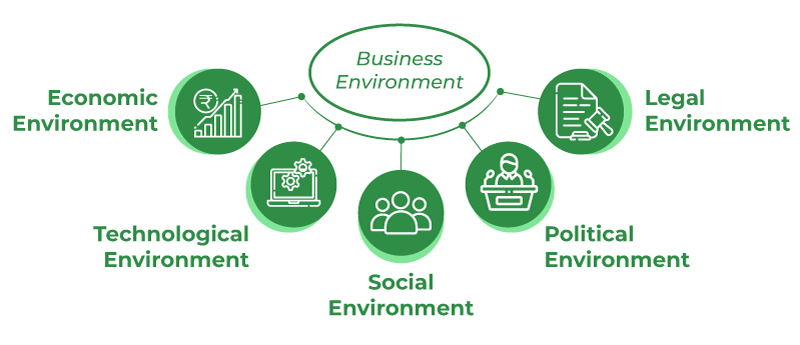Business environment refers to the various internal and external factors that affect the operations and success of a business. These factors include economic, technological, social, and legal aspects, among others. In this blog, we will explore the different components of the business environment and how they impact businesses.
Components of Business Environment
Economic Environment: The economic environment comprises factors such as inflation, economic growth, exchange rates, and interest rates. These factors influence the buying power of consumers, the cost of goods and services, and the availability of resources.
Technological Environment: Technological advancements have transformed the way businesses operate. This environment includes technological innovations, infrastructure, research and development, and the availability of skilled labor.
Social Environment: The social environment includes factors such as demographics, cultural norms, lifestyles, and values. These factors influence consumer behavior, demand for goods and services, and the workforce.
Political Environment: The political environment includes government policies, regulations, and laws that impact businesses. Changes in government policies and regulations can significantly impact the operations and profitability of businesses.
Legal Environment: The legal environment includes laws, regulations, and court decisions that impact businesses. This environment includes labor laws, contract laws, intellectual property laws, and environmental regulations.
Competitive Environment: The competitive environment includes other businesses that offer similar products or services in the same market. The level of competition in an industry can impact pricing strategies, marketing efforts, and customer retention.
Impact of Business Environment on Businesses
The business environment has a significant impact on the success of businesses. Changes in any of the components can create opportunities or threats for businesses. Here are some examples of how the business environment can impact businesses:
Economic Environment: A recession can lead to reduced consumer spending, lower demand for goods and services, and decreased profitability for businesses. On the other hand, a growing economy can lead to increased consumer spending, higher demand for goods and services, and increased profitability.
Technological Environment: Technological advancements can create opportunities for businesses to improve efficiency, reduce costs, and increase revenue. However, businesses that fail to adapt to new technologies risk becoming obsolete.
Social Environment: Changes in consumer behavior and demand can create opportunities for businesses to offer new products and services that align with changing trends. On the other hand, businesses that fail to adapt to changing social norms risk losing market share.
Political Environment: Changes in government policies and regulations can impact the operations and profitability of businesses. For example, changes in tax laws can significantly impact a company’s bottom line.
Legal Environment: Failure to comply with laws and regulations can lead to costly fines, legal fees, and reputational damage. On the other hand, businesses that comply with laws and regulations can build trust with customers and investors.
Competitive Environment: Competition can impact a company’s market share, pricing strategies, and marketing efforts. Businesses that can differentiate themselves from competitors and offer unique value propositions have a better chance of success.
Conclusion
The business environment is complex and dynamic, with various internal and external factors impacting businesses. Understanding the different components of the business environment and how they impact businesses is essential for companies to make informed decisions and stay competitive.




